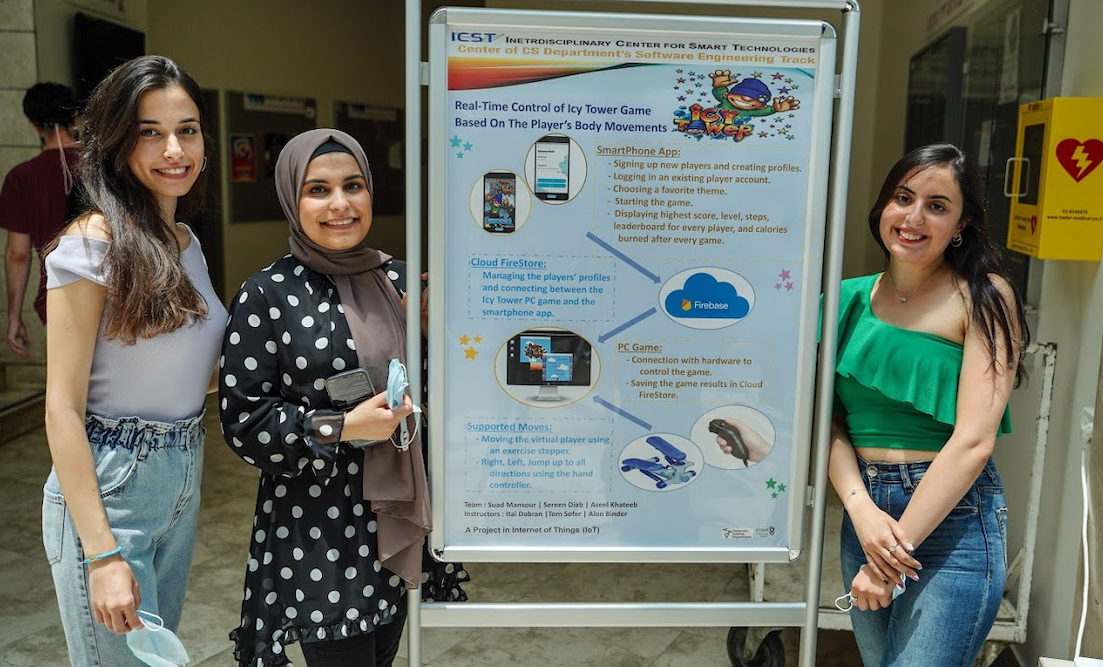Pictured above: Icy Tower team. (L-R) Suad Mansour, Aseel Khateeb, and Sereen Diab
At the end of every term, the Henry and Marilyn Taub Faculty of Computer Science at the Technion holds its annual projects fair, showcasing projects by undergraduate students in their final year. This year, the students presented projects that reflected the fields of computer science they belong to and the subjects they chose to tackle. Some created mobile apps for different uses; some wrote programs to solve diverse problems; some delved into virtual reality; and some built devices, delving into the evolving field of the Internet of Things (IoT).
Multiple student groups chose to use this as an opportunity to help the broader community, and more than one group partnered with the Technion Social Hub to do so.
Small non-governmental organizations (NGOs) often find themselves in need of a software solution, but can neither find an existing platform to cover their particular needs, nor afford custom software. It’s the perfect opportunity for the students to meet this demand, while gaining valuable experience in servicing a client.
This year, three student groups partnered with NGOs to address their software needs.
The first was a project for Friends for Health, by Ido Yam, Tal Manheim, Yaakov Sherma, Illay Hai, and Daniel Shapiro, guided by Eytan Singher and Itai Dabran. Friends for Health is a nonprofit organization dedicated to helping people who cannot afford the life-saving medication they need. Their stock comes from donors who have unused medications that they are willing to donate. The Technion team wrote a computerized interface that accomplishes three of the organization’s goals: it guides patients to the appropriate form for receiving the specific medication they need; it organizes the donation for the donor, adding the possibility for medications to be collected from the donor’s home; and provides management functions for employees. The students’ software would considerably shorten waiting times and enable Friends for Health to assist more patients.
A similar project was provided for Social Delivery by Lior Zelikman, Alex Chirkov, Yagel Meir, and Tal Neoran, guided by Eytan Singher and Itai Dabran. Social delivery is an initiative offering logistical solutions for connecting NGOs to excess stock of things like furniture and textiles. They are now also looking into adding companies replacing office furniture as potential donors. The students digitized the initiative’s donations, requests, and storage tracking. The new interface even lets donors see their past donations, and which NGOs they have helped.
The third project was for the Hadar Social Network and led by Haneen Jeries, Hussein Abu Jabal, Sami Hammoud, and Haitham Kablan, guided by Elazar Gershoni and Itai Dabran. Hadar is a disadvantaged neighborhood in the city of Haifa. In the past years, the neighborhood’s residents have organized efforts and resources to assist each other in whatever way they can. But everything was happening over disjointed WhatsApp conversations, making it difficult to keep track of what was going on, or administer the interactions. The students partnered with the neighborhood council to create a dedicated app, providing a smooth and secure process of connecting volunteers with people who need help. An administrator can ensure the security of the interaction, and a community social worker can use it to provide assistance.
These projects were by no means the only ones that sought to combine a homework assignment with a chance to do good. Other groups dealt with fair trade, donation of excess food from restaurants, accessibility mapping, and more.
Other student groups used the projects as an opportunity to pursue their passions. Almog Algranti, Nadav Abayov, and Yarden Wolf created air drums. Using computer vision algorithms, their app detects the drumsticks in the user’s hands, and plays music as if the user were seated at a drum set, recognising both which drum is being struck, in what manner and with what force. “I play the piano, and recently got interested also in the drums,” Almog explained. “This was an opportunity for me to create a tool that would let me practice without the financial investment in a drum set, and without disturbing the neighbors.”
Suad Mansour, Sereen Diab, and Aseel Khateeb turned the nostalgic “Icy Tower” game into a sports app by attaching an exercise stepper. Now the game character would only move so long as the player kept moving. If the player stopped, the character would fall, resulting in a “game over.” Like any sports app, the three women’s project displays feedback about steps walked and calories burned, as well as the game’s leaderboard. “As children, we played this game, which is a lot of fun,” the three explained, “but it’s not very healthy to spend a long time on the computer, moving nothing but the arrow keys.”
Eliezer Alter, Barel Cohen Adiv, and Eliad Ben Haiem, all of whom live in the student dormitories on the Technion campus, decided to smart-ify their clothesline. Equipped with a water sensor, a light sensor, and a tarp, their clothesline now unrolls the tarp over their clothes if it rains, folds the tarp back when the sun comes out, and even sends reminders to do the laundry when the weather promises to be fine.
Nadav Ashkenazi, Asaf Bialystok, and Nathan Voldman constructed a robotic dog that recognises its owner, follows him around, and barks at strangers. Ethan Baron, Ron Klaz, and Snir Green’s spider recognises music and dances to the rhythm. Daniel Shkolnik, Omer Hemo, and Mordechai Ben Harush created a queuing app for individual exercise machines at the gym.
For Technion students, academic success and real-world outcomes go hand in hand. The faculty puts high value on independent work as part of a graduate’s training process, and the projects are the students’ opportunity to integrate everything they have learned.
Almog Algranti demonstrates the air drums she created with Nadav Abayov and Yarden Wolf


